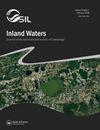新西兰低氮湖泊的磷限制
IF 2.3
3区 环境科学与生态学
Q1 LIMNOLOGY
引用次数: 2
摘要
与北温带湖泊相比,新西兰北岛火山土壤湖泊的总氮:总磷(TN:TP)比较低,夏季分层时溶解无机氮浓度较低,在养分富集生物测定中叶绿素a对N添加的响应大于对P添加的响应。在某些情况下,这种反应导致对一些湖泊集水区施加氮负荷上限,与北温带湖泊的养分管理更侧重于磷管理形成对比。为了探索这种可能存在的限制养分差异,我们将一套在北温带湖泊中广泛使用的基于环境种群化学计量学和代谢活性测量的养分状态指标应用于8个火山地形湖泊,这些湖泊以前报道过氮限制。这些营养状况的测量先前被校准,以告知原位浮游植物是否生长速度有限,如果是,哪种营养物质限制了生长速度。2015年南方夏季,8个湖泊均表现出磷限制迹象,且磷限制比氮限制更为极端、普遍和持久。在没有同时的磷限制证据的情况下,没有观察到氮限制的适应症,但经常在没有氮限制证据的情况下观察到磷限制。其中一个湖,罗托鲁瓦湖,并没有受到强烈的营养限制,浮游植物很可能以或接近最佳的生长速度生长。在本研究中,常用的全氮:总磷比不能很好地预测哪种营养物质可能限制原位浮游植物。本文章由计算机程序翻译,如有差异,请以英文原文为准。
Phosphorus limitation in low nitrogen lakes in New Zealand
ABSTRACT Lakes on volcanic soils of the North Island of New Zealand, compared to north temperate lakes, have low total nitrogen:total phosphorus (TN:TP) ratios, low dissolved inorganic nitrogen concentrations during summer stratification, and have positive chlorophyll a responses to N additions more frequently than to P in nutrient enrichment bioassays. This response has resulted, in some cases, to the imposition of N loading caps on some lake catchments, in contrast to nutrient management in north temperate lakes focused more on P management. To explore this possible difference in limiting nutrients, a suite of nutrient status indicators based on measurement of ambient seston stoichiometry and metabolic activity, which have been widely used in north temperate lakes, were applied to 8 lakes on volcanic terrain with previously reported N limitation. These nutrient status measurements were previously calibrated to inform whether in situ phytoplankton are growth-rate limited and, if so, which nutrient is limiting growth rate. In austral summer 2015, all 8 lakes showed indications of P limitation, and P limitation was more extreme, pervasive, and persistent (among samplings) than N limitation. Indications of N limitation were not observed without contemporaneous evidence of P limitation, but P limitation was frequently observed without evidence of N limitation. One lake, Rotorua, was not strongly nutrient limited, and phytoplankton were likely growing at or near optimum growth rates. In this study the commonly used TN:TP ratio was a poor predictor of which nutrient was potentially limiting in situ phytoplankton.
求助全文
通过发布文献求助,成功后即可免费获取论文全文。
去求助
来源期刊

Inland Waters
LIMNOLOGY-MARINE & FRESHWATER BIOLOGY
CiteScore
6.10
自引率
9.70%
发文量
34
审稿时长
>12 weeks
期刊介绍:
Inland Waters is the peer-reviewed, scholarly outlet for original papers that advance science within the framework of the International Society of Limnology (SIL). The journal promotes understanding of inland aquatic ecosystems and their management. Subject matter parallels the content of SIL Congresses, and submissions based on presentations are encouraged.
All aspects of physical, chemical, and biological limnology are appropriate, as are papers on applied and regional limnology. The journal also aims to publish articles resulting from plenary lectures presented at SIL Congresses and occasional synthesis articles, as well as issues dedicated to a particular theme, specific water body, or aquatic ecosystem in a geographical area. Publication in the journal is not restricted to SIL members.
 求助内容:
求助内容: 应助结果提醒方式:
应助结果提醒方式:


